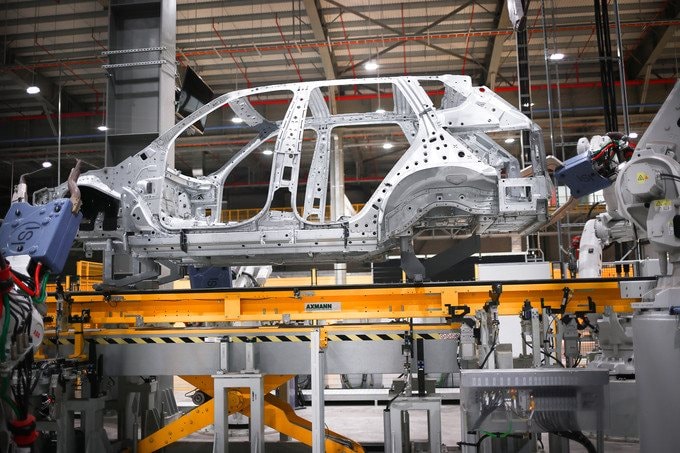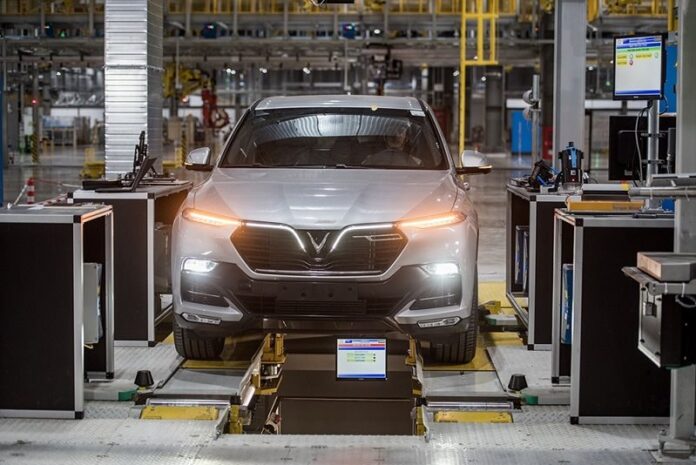
On June 9, VinFast held a conference in Hanoi to boost localization and supplier system development. The Vietnamese automotive brand aims to produce 1 million vehicles annually by 2030 and increase localization to 80% by 2026.
On the sidelines of the conference, Dr. Pham Chi Lan, former Vice President of the Vietnam Chamber of Commerce and Industry (VCCI), shared her insights on the development path of the domestic industry, the role of a capable “leader,” and the reality that Vietnam can achieve more than just being a “screwdriver” economy.

Economic expert Pham Chi Lan.
Opportunity for Domestic Industry
Ma’am, why does Vietnam need to aggressively increase the localization rate of the domestic automotive industry during this period?
I believe this is the time for Vietnam to develop its domestic industries.
As we reflect on 40 years of reform, it’s evident that while our economy has grown at a significant pace, with all sectors making strides, our domestic economic strength, especially in terms of industry, still has many weaknesses.
Currently, more than 50% of the processing and manufacturing industry is dominated by foreign investors operating in Vietnam.
Given the changing global trade landscape, particularly with the tax policies implemented by President Donald Trump in the United States, there will be significant disruptions.
Vietnam will not be able to continue its development if it solely relies on the capabilities of foreign investors.
The risk of them relocating their operations is substantial.
Vietnam must
rise through its own strength and domestic industries to prove that we are producing
our products and not just assembling them for foreign brands, including the components and accessories within.
The
components within these products, especially for
large industrial products like automobiles, require thousands of parts sourced from various countries.
Vietnam will have to demonstrate that we are providing components and accessories for products made in Vietnam and by foreign brands operating here, using local businesses on our soil,
rather than relying solely on imports.
Even the targets of achieving
growth
8% this year and over 10% in the coming years will be challenging if we don’t urgently develop our domestic production capabilities.
Our leaders are highly focused on this issue and are prioritizing the development of domestic industries to strengthen our internal resources.
This presents an opportunity for Vietnamese businesses to step up and for our country to soar through our own industries.
What is the significance of a car manufacturer like VinFast introducing supportive policies for auxiliary enterprises in promoting the localization rate of the automotive industry in Vietnam?
For a long time, we’ve been concerned about the heavy reliance on foreign contractors in some of our industries.
Whether for domestic consumption or export,
we’ve had to use a significant amount of products from
auxiliary industries based overseas. We’ve had policies in place to develop our auxiliary industries for 20-30 years, but we haven’t made much progress, even in relatively simpler sectors like textiles, footwear, or wood processing, where imports still dominate.
It’s only when Vietnam has large enough enterprises to lead and own the supply chain that our auxiliary industries will truly develop.
Without Vietnamese enterprises taking the lead, we won’t be able to establish robust auxiliary industries.
Take the automotive industry as an example. From the beginning, when automotive companies like Toyota and Mitsubishi invested in Vietnam for assembly operations, they relied on their own auxiliary industries, and Vietnam was merely an assembly base.
As a result, Vietnam couldn’t develop its automotive auxiliary industry when foreign enterprises were leading the way. It’s not that Vietnam is incapable, but we lack a leader in this sector.
VinFast’s emergence as a capable leader on a large scale, committed to utilizing local auxiliary products, changes the game.
Auxiliary enterprises that meet VinFast’s high standards and international competitiveness will inherently gain the ability to compete globally.
Indeed, a leader is crucial. When I visited Japan in the 1980s, the chairman of Toyota shared that he only had three factories in Japan.
He explained that large factories only handle the final assembly, while thousands of auxiliary enterprises in various countries form the foundation of Toyota’s success.
Therefore,
the connection between the leader of the supply chain, like Toyota back then or VinFast now, and the auxiliary enterprises is significant.
They need each other.
Especially in the context of Vietnam today, we must be more aware than ever that international integration must go hand in hand with enhancing our internal strength so that Vietnam can rise and compete globally right here on our S-shaped land, not just abroad.
I believe that auxiliary enterprises will receive support from VinFast and society as a whole to thrive together.
We are also proposing, and the government is embracing the idea, to develop policies for foundational industries. Alongside these, we must emphasize the role of auxiliary industries because a large industry cannot stand alone without them.

VinFast aims to achieve 80% localization by 2026.
VinFast’s Commitments are Trustworthy
Vingroup’s leadership emphasizes directions such as enhancing global competitiveness and long-term cooperation for sustainable development. How do you perceive these commitments in terms of their reliability?
VinFast’s commitments are entirely trustworthy, simply because VinFast must fulfill them to survive and thrive in the Vietnamese market and expand internationally.
With automotive products, even the smallest components must be highly compatible and meet stringent standards.
You can’t mix good and bad parts and expect a stable vehicle. Even leading global automakers occasionally recall thousands of vehicles due to flaws in a single component. No one wants that.
So,
naturally, there must be a commitment to high-quality, globally competitive standards.
As for the green requirement, it’s a given in today’s world, and our enterprises must embrace it. In all sectors, companies are striving to meet green requirements because they won’t sell otherwise. I believe that through cooperation, VinFast’s commitment will spread to its auxiliary enterprises.
VinFast and its auxiliary enterprises
will create opportunities for each other, learn from each other, and collaborate to ensure these standards.
In terms of institutional policies, how can the government provide support?
As I mentioned, the government is working on new institutional policies. I hope that businesses will unite and speak up to propose policies that benefit their industries. The government is currently designing these policies while listening to feedback. Prime Minister Pham Minh Chinh has met with businesses and set high expectations while being receptive to their input.
But
we also need the voices of businesses
through various channels, including the media, associations, and your own research, to help the government craft effective policies.
“Following the Success of the $8 Billion Deal, the Prime Minister Proposes New Ventures to the 100,000-Strong Corporation.”
This corporation is a shining star in the international aerospace sector. With a stellar reputation for innovation and excellence, it soars above its competitors. Their cutting-edge technologies and pioneering spirit have propelled them to the forefront of the industry, where they continue to push boundaries and reach new heights.
“Seafood Retail Business Booms: Top Performers Rake in Billions”
As of December 2024, the latest statistics from the Ministry of Finance reveal a thriving business landscape in Vietnam. The country boasts an impressive 3.6 million business households and individual business entities, reflecting a vibrant 106% growth compared to the previous year. This significant increase highlights the dynamic nature of Vietnam’s economy and the entrepreneurial spirit of its citizens.
The Rising Cost of Social Housing
Social housing in Hanoi is becoming increasingly expensive, with some projects reaching up to 27 million VND per square meter. This price surge has sparked concerns among experts, who believe that such high prices exclude a significant portion of low-income earners. With the current regulations in place, individuals earning less than 15 million VND per month would find it challenging to purchase social housing at these elevated rates.





















